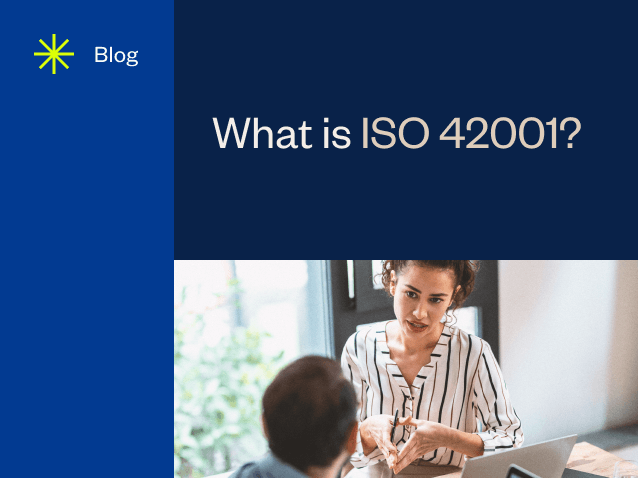Understanding ISO 42001: The World’s First AI Management System Standard

Artificial intelligence (AI) has revolutionized many industries, but its rapid growth has also brought ethical, privacy, and security concerns. To address these challenges, the International Organization for Standardization (ISO) and the International Electrotechnical Commission (IEC) devised a new standard, ISO/IEC 42001 (ISO 42001). Published on December 18, 2023, this standard provides guidance to organizations that design, develop, and deploy AI systems on factors such as transparency, accountability, bias identification and mitigation, safety, and privacy.
This article will explore the key elements of the standard, the benefits of implementing it, and next steps for organizations.
Structure of ISO 42001
Like several other ISO/IEC standards, ISO 42001 has several annexes that provide much of the detailed guidance organizations need. Here’s a quick breakdown of these annexes:
- Annex A: Management guide for AI system development, including a list of controls
- Annex B: Implementation guidance for the AI controls listed in Annex A, including data management processes
- Annex C: AI-related organizational objectives and risk sources
- Annex D: Domain- and sector-specific standards
Key themes of ISO 42001
ISO 42001 covers issues throughout the AI system lifecycle, from the initial concept phase to the final deployment and operation of the system. It is designed to help organizations manage the risks associated with AI and ensure that their AI systems are developed and used responsibly.
Some of the key requirements covered in the published standard include:
- Leadership: Top management should demonstrate leadership and commitment to the AI management system (AIMS) and establish policies and objectives that are consistent with the organization’s strategic direction.
- Planning: Identify and assess risks and opportunities associated with AI and develop a plan to address them.
- Support: Provide resources and support for the AIMS, including training, awareness, and communication.
- Operation: Establish processes and procedures for the development, deployment, and maintenance of AI systems.
- Performance evaluation: Monitor, measure, analyze, and evaluate the performance of AI systems and take corrective actions when necessary.
- Continual improvement: Continually improve the AIMS, and ensure that it remains relevant and effective.
Is ISO 42001 mandatory?
If your organization produces, develops, or uses AI, you may be wondering to what extent you should be scrambling to become certified in ISO 42001. In short, ISO 42001 is a voluntary standard and is not legally binding. However, given its significance and emerging recognition, it is highly likely to become the benchmark for AI management systems in the future. Organizations should anticipate possible regulatory developments and consider proactively adopting ISO 42001.
Organizational roles and responsibilities
Effectively implementing ISO 42001 starts with identifying members of your organization in key roles related to AI:
- AI provider: An organization or entity that provides products or services that uses one or more AI systems. AI providers encompass AI platform providers and AI product or service providers.
- AI producer: An organization or entity that designs, develops, tests and deploys products or services that use one or more AI system. This includes AI developers that are concerned with the development of AI services and products. Examples of AI developers include model designers, implementers, computation verifiers, and model verifiers.
- AI customer: An organization or entity that uses an AI product or service either directly or by its provision to AI users.
Benefits of implementing ISO 42001
Though few organizations relish the idea of more audits, there are good reasons to move forward with certification sooner rather than later. (Plus, if you practice strategic compliance and consolidate your audits, adding ISO 42001 to your compliance program may be easier than you think.)
Managing AI risks and opportunities
ISO 42001 provides organizations with a systematic approach to identify, evaluate, and address the risks associated with AI. This can help organizations mitigate the risks of AI and protect themselves from potential harm.
Competitive advantage
Implementing ISO 42001 enables organizations to showcase their early adopter status, demonstrating their commitment to responsible AI use. This can enhance stakeholders’ trust and distinguish the organization from competitors.
Cost savings and improved efficiency
By incorporating ISO 42001’s best practices, organizations can streamline their AI processes, identify and rectify vulnerabilities earlier, and reduce the potential financial and reputational costs associated with AI failures.
ISO 42001: Next steps for businesses
To navigate the complex landscape of AI governance and compliance, compliance managers should consider the following steps:
- Purchase and understand the standard: Obtain a copy of ISO/IEC 42001 and familiarize yourself with its provisions. It is crucial to understand the requirements, recommendations, and other applicable requirements (i.e. ISO/IEC 22989, ISO/IEC 23894) to effectively implement the standard.
- Start internal talks about certification: Initiating conversations about the certification audit process within your organization is essential. Understanding the steps involved and allocating necessary resources will ensure a smooth transition toward ISO 42001 compliance.
- Get a readiness assessment: Consider engaging a trusted compliance partner like A-LIGN to conduct a readiness assessment tailored to your organization’s specific needs. This assessment will help identify any gaps and provide guidance on achieving ISO 42001 compliance.
As the AI landscape continues to evolve, embracing ISO 42001 will position businesses as leaders in the field, fostering trust and ensuring the long-term success of AI initiatives. Stay ahead in the AI era by leveraging ISO 42001 and building a solid foundation for your AI management system.
